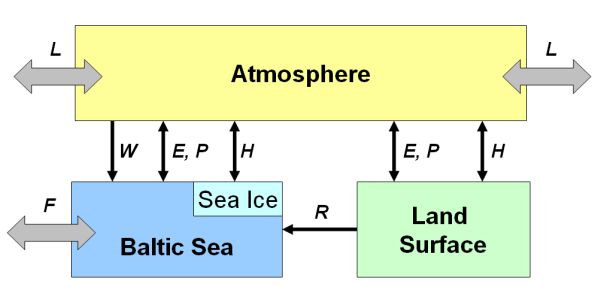Background > The BALTEX Box
The BALTEX Box: A schematic view of the water and energy cycle of the Baltic Sea basin
For the Baltic Sea, a simplified scheme (the so-called “BALTEX box”) represents three interacting reservoirs: the atmosphere, the Baltic Sea and the land surfaces including rivers, lakes and ground water.

The BALTEX Box shows the three "reservoirs" of the water and energy cycle of the Baltic Sea basin and the interactions (fluxes of water and energy) between them.
The atmosphere over the Baltic Sea basin exchanges water and energy via lateral fluxes (L) with the adjacent areas, i.e. the Arctic and Atlantic Oceans, and the eastern and central European land masses. The Baltic Sea receives and loses sea water fluxes (F) through the Danish straits and sounds, which connect the Baltic Sea with the North Sea and the Atlantic Ocean. The atmosphere exchanges water and heat (i.e. energy) with the Baltic Sea and the land surface of the drainage basin (E = evaporation, P = Precipitation, H = Heat exchange). Over the Baltic Sea, wind stress at the sea surface (W), as well as sea ice in winter contribute to the exchange of energy with the atmosphere. River runoff (R) from land returns part of the water which had evaporated from the to the Baltic Sea.
L = Lateral fluxes in the atmosphere, i.e. water vapour and heat which is transported into and out of the Baltic Sea basin from neighboring areas
F = Sea water fluxes through the narrow Danish straits, in and out of the Baltic Sea
W = Wind pressure which is exerted on the sea surface, resulting in waves, and a cooling and mixing of the surface waters
E = Evaporation. This process is different over sea and land, as land based plants actively control their water loss to the atmosphere ("transpiration"); both processes taken together are called "Evapotranspiration"
P = Precipitation: rain, snow, hail, fog drip, sleet.
H = Heat exchange; the Baltic Sea is a large reservoir and can take up heat from the atmosphere, store it for long periods, and slowly give it back to the atmosphere
R = Runoff to the Baltic Sea through rivers. This is essentially the water which rains down over land, and which is not stored in snow cover, ground water or lakes, and which does not evaporate.
Sea ice over the Baltic Sea acts as a barrier between the sea and atmosphere, and in winter may effectively alter the fluxes of water and energy between these reservoirs.
|

